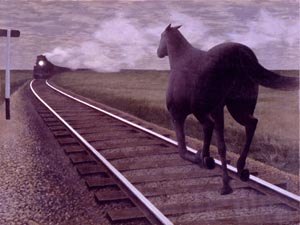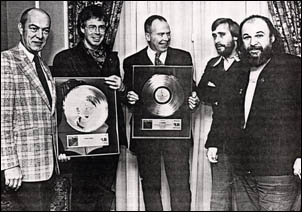ALBUMS:
-- Night Vision (1973) --
Track Listing:
Click song titles to see lyrics, other albums the song appears on, and known comments by Bruce Cockburn on the song. Track lengths are not guaranteed as they occasionally change with format (i.e. CD/vinyl) and release version.
 [1] Foxglove (1:29)
[1] Foxglove (1:29)
[2] You Don't Have to Play the Horses (3:50)
[3] The Blues Got the World... (1:52)
[4] Mama Just Wants to Barrelhouse All Night Long (4:14)
[5] Islands in a Black Sky (7:40)
[6] Clocks Don't Bring Tomorrow -- Knives Don't Bring Good News (6:49)
[7] When the Sun Goes Nova (2:43)
[8] Deja Vu (5:36)
[9] Lightstorm (2:34)
[10] God Bless the Children (4:18)
Order the 'Night Vision' (1973) album from Amazon.com now
or check out other albums in the Project's Online Store
Album Info:
Of all the albums i've been involved with, this has been the most exciting
for me, and the one i'll probably be able to actually listen to in times to
come (thanks to the fine playing of Dennis, John and Pat). The music is both
a departure and a return. For various shifts and reenforcements of point of
view, i'm indebted to:
Kitty, Gene
Samuel R. Delaney (Driftglass)
Django Reinhardt
L. Durnell, (and my brother)
John (the Alexandria Quartet)
David Wiffen (in spite of himself)
life going round and round
I hope you like it
-Bruce Cockburn
All songs written by B. Cockburn © 1973 Golden Mountain Music Corp. (SOCAN)
(BMI) All Rights Reserved. Used by Permission.
Produced by Eugene Martynec and Bruce Cockburn for True North Productions
Recorded at Thunder Sound between February and May 1973
Engineer: Bill Seddon
Rehearsals and Pre-Production at Tatsi (Toronto)
Digitally Remastered by Vic Anesini, Sony Studios, NY
Musicians:
Pat Godfrey-Keyboards
Dennis Pendrith-Bass
John Savage-Percussion
Bruce Cockburn-Guitars, Banjo, Vocals
Cover Painting: A. Colville (1954)
Inside Photo and Art Direction: Bart Schoales
Editor's Note: The cover art is a reproduction of an Alex Colville painting called "Horse and Train" (1954), Glazed Tempera on hardboard 41.2 x 54.2 cm Art Gallery of Hamilton, gift of Dominion Foundries and Steel Limited. The commentary of the National Gallery of Canada throws a whole new light on why Cockburn might have chosen this painting for the album:

Thus abandoned and solitary in the world, human beings are forced to
confront their own freedom, a freedom to choose that is both demanding and
deadly serious. One of Colville's best-known works, Horse and Train, goes
straight to the heart of this source of human anxiety and raises an
essential question: can destiny be altered? A helpless witness to imminent
disaster, the viewer of this painting can never know the outcome. Clearly,
the train cannot deviate from its track, but the horse has a choice - we
think. Is it mesmerized by the light? Is it challenging a foe? Is it aware
of the terrible danger? If not, can the engineer stop the train in time? The
animal may be driven by instinct, but the human faces an ethical dilemma: Is
it worth stopping? How much does the death of a horse matter? Which is more
dangerous - to brake and cause a possible derailment, or to keep going and
risk a deadly collision? Can we halt time - the little that remains?
The picture was inspired by a poem published in 1949 by the South African
writer Roy Campbell. Words by Wilfred Owen serve as the poem's epigraph:
"None will break ranks." The poem itself includes the lines: "Against a
regiment I oppose a brain / And a dark horse against an armoured train."
During his military career, Colville had exhibited an independence of mind
that was not always appreciated by his superiors; it is a characteristic he
subsequently cultivated, like his opposition to the various forms of
20th-century abstraction. In Horse and Train, the artist seems to be
emphasizing the unavoidable need to make choices: despite the apparently
hopeless situation and the magnetic power of the train's light over the
animal, we are witnessing a confrontation between two freedoms. The horse is
free to change direction, the engineer to engage the brakes.
28 May 2002
Bruce Cockburn gave the following speech when Alex Colville was inducted to Canada's Walk of Fame.
"I think it was Christmas of '73, I was given a book featuring the work of a Canadian painter whose name was new to me. The paintings were striking - perfectly executed, realistic, but with a depth, a kind of transcendence that spoke to me of a larger reality.
One painting in particular jumped out at me. In it, a well-muscled black horse gallops headlong down a railway track, straight at an oncoming train. The horse seems to contain such energy, it's as if it were a charged particle of pure spirit. This sense of spirit, in confrontation with material power, is something any artist can relate to.
A sense of impending doom too, I think.
I certainly did! Some months later, as we got into working on what was then the "new" album,
I kept thinking of the painting, feeling a connection between it and the music we were making.
Music which was a little different from the preceding three albums. In part, a reaction against the
hemmed-in feelinq of having been filtered and "labelled" by media and
music business expectations. We approached the artist about using his
work on the cover of that album and he graciously said "yes". The
album was "Night Vision", the paintinq "Horse and Train", the
painter Alex Colville.
Known comments by Bruce Cockburn about this album, by date:
Circa 1986
"Sunwheel Dance seemed to finish off a certain thread- I got worried about the
typecasting I was getting, ergo, Night Vision, an urban exploration, somewhat
tentative it now appears."

Picture of Terry Lynd (CBS), Bruce Cockburn, Alex Colville (artist of painiting used for Night Vision album cover), Bill Bannon (CBS), Bernie Finkelstein.
-- from the World Of Wonders Tour Program, circa 1986. Submitted by Rob Caldwell
November 1999
Steve Lawson: Was there a parallel between the music and lyrics in that development [use of the electric guitar]?
BC: The earliest album that has a real noticeable amount of electric guitar on
it is Night Vision, which is also a dark kind of record and I hadn't thought
about it but I guess that's true, it does contribute to it, though
unconsciously - I must contribute to what I was doing. The choice wasn't
unconscious the connection was...
-- from Bruce Cockburn Interview, Guitarist Magazine, November, 1999, by Steve
Lawson.
December 1995
"Where Were You in 1974?"
This question was posed to
Bruce in 1994, read y'all about it:
"The most significant thing I can recall doing that
year was doing an album called Night Vision. I hadn't
planned on doing an album then but I was producing an
album for a Canadian artist who had one album out and
was at odds with his record company- they were stuck
with the need to make a record and nobody to produce
it so they got me.
The album got put on the shelf because the artist had
a drinking problem, but I had put a band together- it
was the first time I'd worked with an actual band
since the '60s, when I was playing in garage bands- to
do that album. When the artist became incapacitated
for a period, we decided to learn a bunch of my songs
and go into the studio to do Night Vision. It was a
complete accident.
It was the beginning of a whole bunch of things.
Prior to that, for three albums, we had gone into the
studio and built it around me and added people as
needed for each song. With this one it was an actual
band and part of it became the first band I toured
with. That album was more urban in nature than ones
I'd done before, and more humorous.
I actually stopped listening to pop music during this
period. I'd played in a bunch of bands in the '60s-
everything from questionable R&B to questionable
psychedelia- and I really got sick of the whole thing
after awhile. There was a great hunger on my part,
and I felt it would probably be shared by other
people, for something kind of quiet and to the point,
instead of long, meandering solos. That feeling did
seem to be shared by a lot of people."
-- from Gavin's Woodpile, December 1995. Submitted by Rob Caldwell.
Help out! To add material to this section, see this page first.
Albums Index
This page is part of The Cockburn Project, a unique website that exists to document the work of Canadian singer-songwriter and musician Bruce Cockburn. The Project archives self-commentary by Cockburn on his songs and music, and supplements this core part of the website with news, tour dates, and other current information.

 [1] Foxglove (1:29)
[1] Foxglove (1:29)
